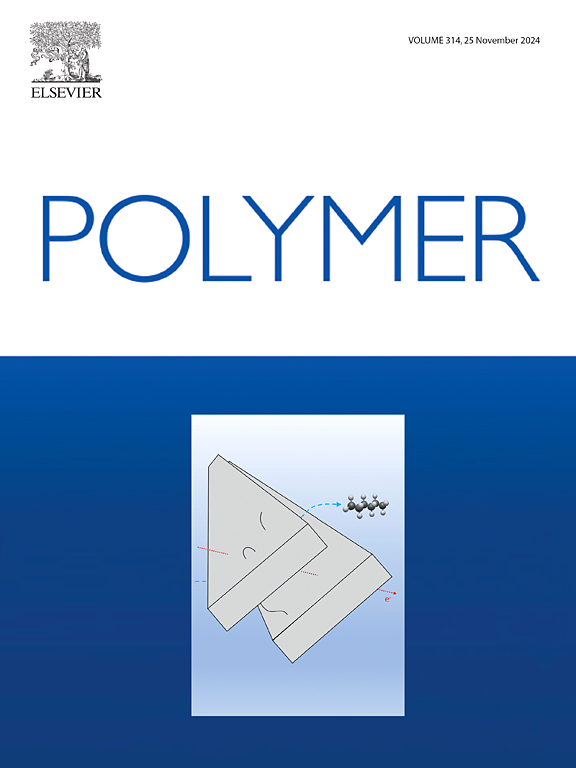随机氟化与嵌段氟化聚丙烯酸酯制备2K聚氨酯疏水性透明涂层的比较研究
IF 4.1
2区 化学
Q2 POLYMER SCIENCE
引用次数: 0
摘要
本研究以2-(全氟己基)甲基丙烯酸乙酯、甲基丙烯酸羟乙酯和甲基丙烯酸甲酯为原料,分别通过传统的自由基聚合和原子转移自由基聚合,合成了三种不同氟含量的随机氟化聚丙烯酸酯(即F1H1、F3H1和F5H1)和一嵌段氟化聚丙烯酸酯(即PFPHM)。这些共聚物进一步作为疏水性添加剂掺入到2K聚氨酯(PU)透明涂层中。研究了氟化聚丙烯酸酯的种类和用量对改性涂料的雾霾性能、表面疏水性、室外疏水性耐久性和耐污性能的影响。氟含量较高的氟化聚丙烯酸酯添加剂更易使2K PU透明膜产生雾霾,但用量较低可获得疏水表面,减轻了其对透明度的负面影响。由于PFPHM易于在2K PU透明涂层的表层富集,因此与随机聚丙烯酸酯添加剂相比,PFPHM表现出极高的疏水性改性效率。此外,pfphm改性的2K PU涂料在室外暴露试验中表现出最好的疏水性耐久性和耐污性。室外疏水性的损失主要是由于PU基体老化,氟烷基链的损失,部分是由于污垢的附着。本文章由计算机程序翻译,如有差异,请以英文原文为准。


Comparative study on random and block fluorinated polyacrylates for fabrication of hydrophobic 2K polyurethane clearcoats
In this study, 2-(perfluorohexyl)ethyl methacrylate, hydroxyethyl methacrylate and methyl methacrylate were used to synthesize three random fluorinated polyacrylates with various fluorine contents (i.e., F1H1, F3H1, and F5H1) and one block fluorinated polyacrylate (i.e., PFPHM) through traditional radical polymerization and atom transfer radical polymerization, respectively. These copolymers were further adopted as hydrophobic additives to incorporate into 2K polyurethane (PU) clearcoats. Effect of the type and dosage of the fluorinated polyacrylate on the haze, surface hydrophobicity, outdoor hydrophobicity durability and dirt pick-up resistance (DPUR) of modified coatings were investigated. Fluorinated polyacrylate additive with higher fluorine content is easier to cause haze of 2K PU clearcoats, nevertheless, hydrophobic surface could be acquired at lower dosage, alleviating its negative effect on transparency. PFPHM showed extremely higher hydrophobicity modification efficiency compared to the random polyacrylate additive, due to its easy enrichment at the superficial layer of 2K PU clearcoats. Moreover, PFPHM-modified 2K PU coatings presented the best hydrophobicity durability and dirt pick-up resistance in outdoor exposure test. The loss of hydrophobicity outdoors was mainly due to the aging of PU matrix, loss of fluoroalkyl chains, and partially to the dirt adhesion.
求助全文
通过发布文献求助,成功后即可免费获取论文全文。
去求助
来源期刊

Polymer
化学-高分子科学
CiteScore
7.90
自引率
8.70%
发文量
959
审稿时长
32 days
期刊介绍:
Polymer is an interdisciplinary journal dedicated to publishing innovative and significant advances in Polymer Physics, Chemistry and Technology. We welcome submissions on polymer hybrids, nanocomposites, characterisation and self-assembly. Polymer also publishes work on the technological application of polymers in energy and optoelectronics.
The main scope is covered but not limited to the following core areas:
Polymer Materials
Nanocomposites and hybrid nanomaterials
Polymer blends, films, fibres, networks and porous materials
Physical Characterization
Characterisation, modelling and simulation* of molecular and materials properties in bulk, solution, and thin films
Polymer Engineering
Advanced multiscale processing methods
Polymer Synthesis, Modification and Self-assembly
Including designer polymer architectures, mechanisms and kinetics, and supramolecular polymerization
Technological Applications
Polymers for energy generation and storage
Polymer membranes for separation technology
Polymers for opto- and microelectronics.
 求助内容:
求助内容: 应助结果提醒方式:
应助结果提醒方式:


